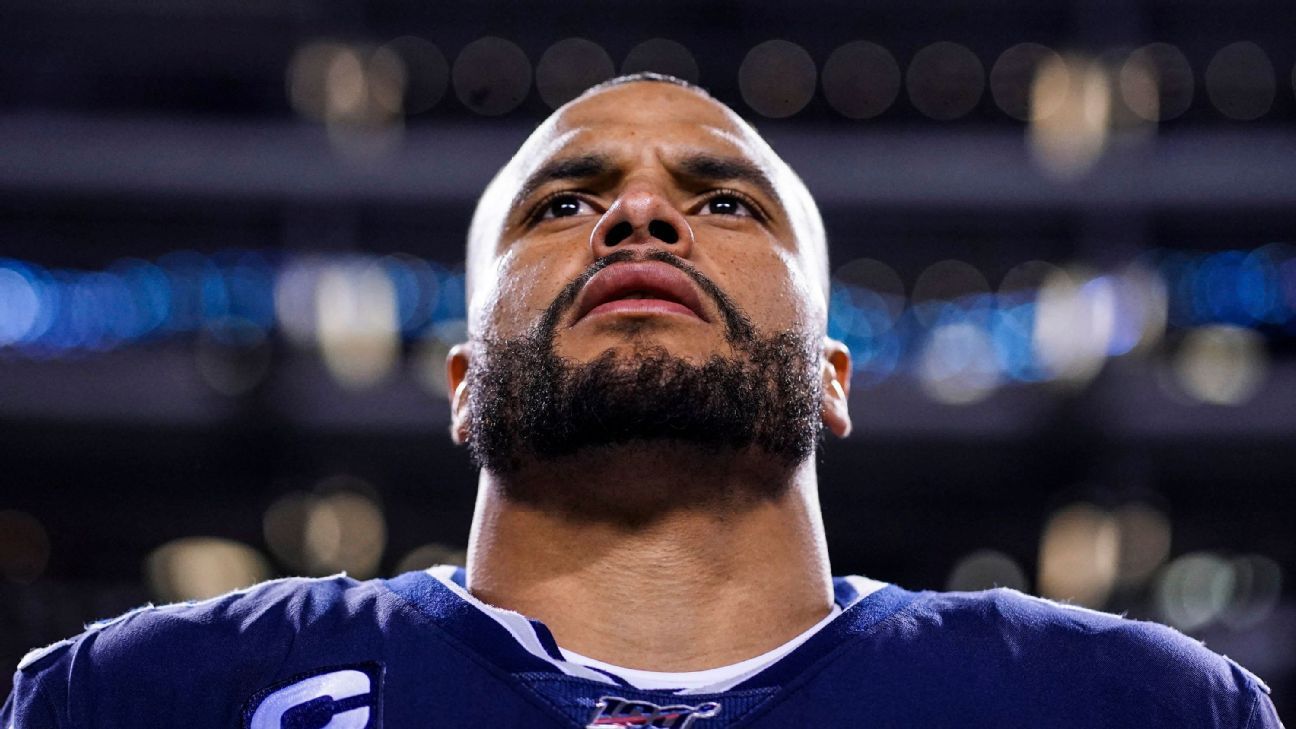There have been many theories laid out as to why the Dallas Cowboys haven’t committed to a long-term deal with quarterback Dak Prescott. Below, we identify and evaluate a few.
Ezekiel Elliott, not Prescott, drives the Cowboys’ offense
Over his career, Prescott has a higher Total QBR on plays with Elliott off the field (71.3) than he does with him on (70.3). From 2016 to 2019, the only qualified quarterback with a 71.3 QBR is Patrick Mahomes (78.2).
Just keying in on the takeaway that Prescott is better without Elliott than with is simplistic, but it’s close. There’s a similar split with his yards per attempt (7.65 with Elliott and 7.53 without) and first-down percentage of pass attempts (37% with, 35% without).
As a team, Dallas’s third-down percentage without Elliott (43.5) is barely better than with him (43.3).
Another way to examine Prescott’s passing without the threat of Elliott is to look at his performance in empty sets. The NFL calls a pass play on 98.8% of plays with an empty formation (not surprising), so it’s relevant to see how Prescott does when his formation signals an obvious pass before the snap.
Prescott’s performance out of empty sets has been better than good — his 83.2 Total QBR ranks fourth among qualified quarterbacks (behind Mahomes, Lamar Jackson and Andrew Luck). He has thrown for 14 touchdowns with five interceptions and averaged 7.7 yards per attempt out of empty sets, ranking in the top 10 in both touchdown-to-interception ratio and yards per attempt among quarterbacks with 100-plus of those passes over the past four years.
The offensive line makes it easy on Prescott
The Cowboys’ offensive line is an asset. But no line is perfect, and should this logic be used to discount Prescott’s value, his performance on those plays when the line breaks down should be a red flag.
Except Prescott is pretty solid here, too. Prescott has a 33.6 Total QBR when pressured in his career, which sounds low until you remember all quarterbacks struggle under pressure. The NFL average is 21.2, and Prescott’s 33.6 ranks seventh among the 40 quarterbacks with 200-plus pass plays under pressure. Notable names behind Prescott in pressured QBR since 2016 include Tom Brady, Matt Ryan, Russell Wilson and Aaron Rodgers — that’s a combined eight Super Bowl wins and six league MVP awards.
Prescott has been better than average in both completion percentage (45.7%) and off-target percentage (27.9%) when pressured, though they haven’t necessarily been high-risk throws (ranks 25th in average-throw distance when pressured at 8.1 yards downfield). Still, his 26.2% first-down percentage is close to the league average as well (26.5%) and suggests he doesn’t fall to pieces as a passer when his protection breaks down.
Prescott can’t beat good teams
There really is no hiding how poorly Prescott has played against good opponents in his first four seasons. He has played 18 career games against teams that would finish with 10-plus wins, and his performance hasn’t been stellar.
The most lasting impression of Prescott’s performance against good teams isn’t great either; he went 0-5 against 10-win teams in 2019, a season that ended with the 8-8 Cowboys finishing one game behind the 9-7 Eagles for the NFC East crown.
Teams can’t be successful overpaying a QB
At over $31 million on a one-year deal for 2020, Prescott would be occupying 14.3% of Dallas’s 2020 salary cap. Sixty quarterbacks have started a playoff game over the past five years and 11 occupied at least 14% of their teams’ salary cap in the year they started a playoff game (see inline chart).
Only Matt Ryan reached the Super Bowl, and his Falcons lost. The average cap percentage of a Super Bowl starter over the past five years was 9.27%, with as many quarterbacks below 5% as above 11%.
In fact, exactly twice as many playoff quarterbacks occupied less than 6% of their teams’ cap that season (22), and that’s going by the team’s designated starter (i.e., using Derek Carr’s cap hit instead of Connor Cook’s in 2016, though Cook started the game for the injured Carr; other examples include Matt Moore and Ryan Tannehill, AJ McCarron and Andy Dalton).
The final piece of this problem for Prescott has nothing to do with his play. Dallas has less than $5 million in 2020 cap space, and over 80% of its 2021 cap is allocated. Should the coronavirus pandemic lead to a decrease in NFL revenue, team salary caps could shrink. ESPN analyst Adam Schefter had one potential early estimate at a $70 million to $80 million decrease in the 2021 cap. That would move a massive Prescott extension from problematic to disastrous. Excluding his franchise tag figure, the average of the top 10 QB cap hits next year is $24.9 million, or over 18% of a $137 million salary cap ($75 million below the current $212 million projection).
And that might be conservative looking at what sort of contract Prescott’s camp could justify. Look at the recent players to reset the average annual value market. Prescott’s 2019 QBR stacks up very well. He might not reset the market (led by Russell Wilson’s $35 million a year), but even a deal at $30 million would occupy almost 22% of a $137 million cap.
